The name Braxton Bragg has become synonymous with Confederate defeat during the American Civil War. Even today, you will not find too many people to stand in your corner should you wish to rehabilitate the South's most controversial general.
There is a story which, whether true
or untrue, shows the depth of that feeling. As
late as 1969, a respected author began what was
to be a two volume biography on Bragg.
However, by the time he had reached the battle of
Murfreesboro, i.e. 1862, he was so disgusted by
Bragg's character that he wound up the book and
turned the project over to one of his students. I
have yet to read the book, but the tale is
indicative of the feelings most Civil War
observers have of Braxton Bragg.
Bragg's trouble began when he took
command of the Confederacy's second most
important field command, the Army of Mississippi
more famous later as the Army of Tennessee. Up
until then, his career had been relatively
distinguished despite his abrasive manner with
brother officers and the men under his command.
He had finished fifth from a class of fiftyfive at
West Point in 1837. He was present with the army
against the Seminole Indians in Florida, although
never actually in combat. Thereafter, he spent his
time on the western frontier of the expanding
United States. It was here that Bragg committed
the ludicrous theatre of arguing with himself.
Ulysses S. Grant recalled the infamous story
when Bragg was acting both as company
commander and post quartermaster. 'As commander of the company he made a requisition upon the quartermaster - himself - for something he wanted. As quartermaster he declined to fill the requisition, and endorsed on the back of it his reasons for so doing."
Unbelievably, Bragg carried on the altercation with himself over several communications and eventually referred the matter to the post commander who exclaimed, "My God Mr. Bragg, you have quarreled with every officer in the army and now you're quarreling with yourself."
During the Mexican War, Bragg commanded Battery C, 3rd U.S. Artillery, and performed with valour, winning three brevets and impressing his superiors. Bragg resigned from the army in 1856 and by 1861 had risen to Major General in the Louisiana State Militia. On the plus side he was described as energetic, intelligent, of high moral character, a skillful planner and in
Richmond circles, a "great General."
On the down side, he was vague, unpopular to the point of detestation, argumentative, and unable to compromise. A British observer during the war, Lt. James Fremantle, had this to say of Bragg: a sickly, cadaverous, haggard appearance, rather plain features bushy black eyebrows which unite in a tuft on the top of his nose, and a stubby iron-gray beard.
The constant quarrels and command crises, through which the Army of Tennessee suffered under Bragg, may have been used by some of his subordinates during and after the war, to deflect too close an investigation into their own mismanagement of operations. Which, if they had been carried out as Bragg had wished, may have rescued his reputation, or at the very least, toned down the effects of a seemingly endless stream of defeats.
By 1863, Bragg distrusted and was in
turn despised by at least half his officer corp.
These sentiments percolated through to the men
in the ranks. In respect of his troops, one
disgruntled footslogger wrote of Bragg: "He shot
half of them himself in Kentucky, and the
Yankees killed the other half of them up at
Murfreesboro." Granted there are not too many
instances where Bragg got it right. However, I
would like to look closely at one in which the
blame lies entirely with his commanders, and had his orders been carried out
promptly, may have had a lasting effect on the war in the West.
After the battle of Murfreesboro it
was anticipated that Union Major General
William S. Rosecrans would advance on the
important Confederate transport hub of
Chattanooga. Indeed, Washington required
Rosecrans to apply pressure against Bragg in
order that troops from Bragg's army would not be
used to support Pemberton at Vicksburg as the
latter faced the troops of U.S. Grant. In a
masterful stroke and without a pitched battle,
Rosecrans maneuvered Bragg from his positions
covering Chattanooga. The town itself however
remained under Confederate control and was too
well defended to be taken by assault.
Having fooled Bragg once, Rosecrans
was confident he could do it again and therefore
decided to approach the town from the west. The
terrain immediately to the west of Chattanooga is
not suited to the movement of large armies; the
roads are poor and a series of barren mountainous
ridges runs almost north-south interspersed by
easily defended gaps. The area could not supply a
large army, and should the Federals get bogged
down in the mountains they would inevitably have
to retreat.
Despite minor delays and irritations,
Rosecrans got his men across the Tennessee River
by September 4. A succession of fake deserters
and faulty intelligence led the general to believe
that the Confederates would not make a fight this
side of Atlanta, and he was impatient to get his
men through the mountains. The Union cavalry
was sent to the extreme right flank to operate
against Rome and Alpine, Georgia. Alexander
McCook's XX Corps were to the left of the cavalry
and were to seize Winston's Gap at the southern
end of Lookout Mountain. George Thomas' XIV
Corps was to take Cooper's and Stevens' Gaps in
Lookout Mountain approximately 15 miles
further north. Thomas Crittenden's XXI Corps
was to follow behind Thomas, then strike out for
the northern end of Lookout Mountain in order to
threaten the rail line close to Chattanooga.
Rosecrans had stretched his army to the limit:
the distance between both flanks was nearly 40
miles. In the city, Bragg was completely at a loss
as to where Rosecrans' army was located, and
from which direction it would strike. On
September 6, Bragg's nerves gave way. He
abandoned the city to concentrate his forces at La
Fayette, Georgia, presumably to keep them out of
harms way and to let the situation develop in
order to make a counterstroke. By September 8,
the Federals stood on Lookout Mountain looking
into the fertile basin of McLemore's Cove.
Columns of dust in the distance gave the lie that
Bragg was on the retreat.
Astonishingly, Bragg was saved from indecision by a Northern newspaper report: "If Crittenden succeeds well in his efforts upon Chattanooga and will not need reenforcements, Thomas and McCook will move rapidly upon Rome, Georgia." Putting this intelligence along with
the poor responses his scouts had delivered, Bragg could surmise that the Federals were
about to debouch from the mountains.
If he moved quickly enough, the opportunity
presented itself to defeat Rosecrans in detail.
Despite his good fortune, Bragg was still unsure
as to exactly where the Yankees would appear.
On September 9, however, he at last received
news that placed Negley's Union division at
Davis' Crossroads in McLemore's Cove. Bragg
ordered Major General Thomas Hindman
(pronounced as in Golden Hind) to move directly
on the crossroads and once there take command
of Cleburne's division of Hill's Corps, which
would arrive through Dug Gap, and attack
immediately.
HDQRS. ARMY OF TENNESSEE
GEN.: You will move with your division
immediately to Davis' Cross-Roads, on the road from
La Fayette to Stevens's Gap. At this point you will put
yourself in communication with the column of Gen.
Hill, ordered to move to the same point, and take
command of the joint forces, or report to the officer
commanding Hill's column according to rank. If in
command you will move upon the enemy, reported to
be 4,000 or 5,000 strong, encamped at the foot of
Lookout Mountain at Stevens' Gap. Another column of
the enemy is reported to be at Cooper's Gap; number
not known. I am, general, &c., HDQRS. ARMY OF TENNESSEE
GEN.: I inclose orders given to Gen. Hindman.
Gen. Bragg directs that you send or take, as your
judgment dictates, Cleburne's division to unite with
Gen. Hindman at Davis' Cross-Roads tomorrow
morning. Hindman starts at 12 o'clock to-night, and
he has 13 miles to make. The commander of the
column thus united will move upon the enemy
encamped at the foot of Stevens' Gap, said to be
4,000 or 5,000. If unforeseen circumstances should
prevent your movement, notify Hindman. A cavalry
force should accompany your column. Hindman has
none. Open communication with Hindman with your
cavalry in advance of the junction. He marches on the
road from Dr. Anderson's to Davis' Cross-Roads.
I am, general, &c., Major General James Negley's Union
division on arrival in McLemore's Cove was
informed by locals that the Confederates were in
force on the far side of Pigeon Mountain. For the
time being, Negley was aware that he was on his
own. He was also aware that his orders were to
push on as swiftly as he could.
As his advanced elements met Rebel
outposts in Dug Gap, Negley's fears got the
better of him and he decided to pull back and take
up a position around the Davis Plantation to
await the rest of the Corps. Corps commander
Major General George Thomas concurred with
Negley's decision, couriers were despatched to
hasten the arrival of Baird's division which was a
day behind, the divisions of Reynolds and
Brannen were to come up on Negley's left via
Cooper's Gap.
By the time Thomas withdrew, only
Baird and Turchin's brigades would have turned
up to support Negley. Rosecrans did not fully
understand Thomas' position and was in no
mood to accept any delay to his plan. He urged
Thomas to move faster and threaten La Fayette in
the belief that Bragg was fleeing south. At dawn
on September 10, Hindman was within four miles
of the Widow Davis Plantation when Bragg's
plan began to unravel, Daniel Harvey Hill, no
lover of Bragg, informed his commander that he
could not obey his orders. He reported Cleburne
sick and doubted whether the timber obstacles
previously placed in Dug Gap could be cleared in
time for his men to advance, or subsequently, for
Hindman to use in the event of a withdrawal.
Still intent on grabbing the opportunity,
Bragg altered his plan and ordered General
Simon Bolivar Buckner to rush forward two of his
divisions instead. As the day wore on, Hindman
became even more cautious. Locals had reported
not one, but two Federal divisions in the area, and
he had heard nothing yet from Hill about
Cleburne. Buckner united with Hindman at 4:45
p.m.
Meanwhile, on the other side of Pigeon
Mountain, the obstinate Hill had changed his
mind and ordered Cleburne forward into Dug Gap
at 1:30 p.m. Despite Hill's previous protestations,
the Irishman's excellent soldiers cleared the
timber restrictions in the gap in record time.
Believing things to be at last going his way, Bragg
again attempted to move Hindman.
HDQRS. ARMY OF TENNESSEE
GEN.: The enemy is now divided. Ourforce at
or near La Fayette is superior to the enemy. It is
important now to move vigorously and crush him. I
am, general, very respectfully, your obedient servant,
KINLOCH FALCONER, Assistant Adjutant-Gen
Bragg arrived in La Fayette at 11:30
p.m. on September 10. Unfortunately for the
Confederate cause and his own reputation he did
not ride another dozen miles to kick Hindman's
backside. A further despatch sent at midnight did
not reach Hindman until 4 a.m. This time there
was no room for misinterpretation.
HDQRS. ARMY OF TENNESSEE
GEN.: Hdqrs, are here, and the following is the
information: Crittenden's corps is advancing on us
from Chattanooga. A large force from the south has
advanced to within 7 miles of this point. Polk is left at
Anderson's to cover your rear. Gen. Bragg orders you
to attack and force your way through the enemy to this
point at the earliest hour that you can see him in the
morning Cleburne will attack in front the moment your
guns are heard.
I am, general, &c., Despite all this, Bragg, Hill and
Cleburne waited in vain the next morning at Dug
Gap for the sound of Hindman's guns. The
General moved out at 6:30 a.m. for the Widow
Davis Plantation but stopped two and a half miles
short in order to reconnoiter. These operations
were not concluded to Hindman's satisfaction
until noon, by which time the Federal forces had
begun to withdraw to Bailey's Crossroads.
Hindman's 'assault' therefore merely followed up
this rearward move by the Yankees.
Bragg's first chance of destroying a
part of Rosecran's army before that commander
became aware of his danger faded as darkness
settled over the Cove. Despite everything, Bragg
had clung to his original idea of delivering a
telling blow to the Union army. His only major
failing throughout had been to rely on his
unsupervised subordinates carrying out their
orders. Something which we presume generals
should take for granted, but which during the Civil
War more often than not led to disaster.
Daniel Harvey Hill as usual caused
trouble for his superior, a trait with which only
Robert E. Lee seemed able to cope with. In the end
however, he had acquiesced and moved his
troops forward. Thomas Hindman, on the other
hand, had chosen to misinterpret or ignore every
order urging him in plain language to attack. The
real blame for this lost opportunity must lie with
him. Eighteen days later Bragg penned the
following despatch:
NEAR CHATTANOOGA via
Chickamauga Gen.: Maj. Gen. Hindman and Lieut. Gen. Polk
have been suspended from their commands by my
orders and sent to Atlanta, for not obeying orders on
the 11th and 20th instant. This has been deemed
necessary after grave consideration. BRAXTON
BRAGG, Gen., Comdg.
This article appears in MagWeb (Magazine Web) on the Internet World Wide Web.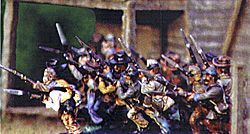 GOING TO MEET THE FEDEBALS IN THE GAP: Large 25mm figures are mostly Firing Line with some Elites. Buildings Created by HG Walls. Photo by Ivor Janci.
GOING TO MEET THE FEDEBALS IN THE GAP: Large 25mm figures are mostly Firing Line with some Elites. Buildings Created by HG Walls. Photo by Ivor Janci.
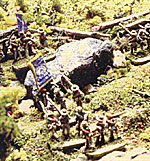 CONFEDERATES AT McLEMORE's COVE. Photo courtesy John Hill.
CONFEDERATES AT McLEMORE's COVE. Photo courtesy John Hill.
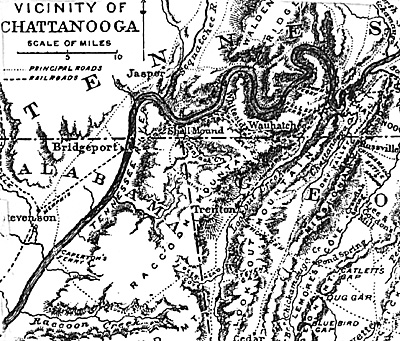 Map courtesy John Hill.
Map courtesy John Hill.
Lee and Gordon's Mills
September 9, 1863
11.45 P.m.
Maj. Gen. HINDMAN, comdg. Division:
KINLOCH
FALCONER, Assistant Adjutant-Gen.
Lee and Gordon's Mills
September 9, 1863
11.45 P.M.
Lieut. Gen. HILL, Comdg.
Corps:
KINLOCH
FALCONER, Assistant Adjutant- Gen.
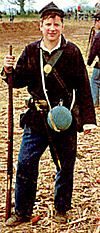 One of Rasecran's Bluebellies? Possibly. in truth it's our author of this article, George Anderson, as a Union reenactor. George hails from Scotland (and purportedly is brave, ahem), and is the coauthor of eight fine scenario booklets from Potomac Publications.
One of Rasecran's Bluebellies? Possibly. in truth it's our author of this article, George Anderson, as a Union reenactor. George hails from Scotland (and purportedly is brave, ahem), and is the coauthor of eight fine scenario booklets from Potomac Publications.
Gordon's Mills
September 10, 1863
7.30 P.M.
Maj. Gen. HINDMAN, Comdg.:
La Fayette, Ga.
September 10, 1863
12 P.M.
Maj. Gen. HINDMAN, Comdg., &c.:
GEORGE WM.
BRENT Assistant Adjutant-Gen.
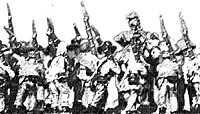
September 29, 1863
Gen. S. COOPER, Adjutant
Inspector
Back to The Zouave Number 49 Table of Contents
Back to The Zouave List of Issues
Back to Master Magazine List
© Copyright 1999 The American Civil War Society
Other military history articles and gaming articles are available at http://www.magweb.com